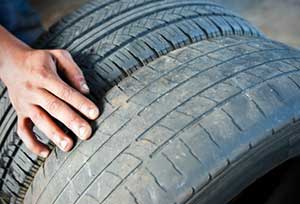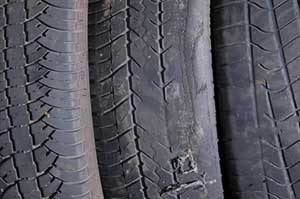Why Do Wheel Alignment?
From the driver’s point of view, there are several reasons why you should ensure your wheels are correctly aligned. Hopefully most of these are obvious!
- To ensure even tyre wear. Unevenly worn tyres can be dangerous as grip and vehicle handling are inferior.
- To get the longest life out of your tyres
- To avoid breaking the law - unevenly worn tyres could be illegal!
You should also have your wheels aligned when:
- Your vehicle has had a minor accident especially involving the suspension or chassis.
- You frequently drive over rough ground.
- Your vehicle pulls to one side, so you need to apply constant pressure to the steering in order to maintain a straight line.
- Your car reaches a certain age. After many miles, some suspension components will wear enough to cause wheel misalignment. Some manufacturers recommend a check at certain intervals - see manufacturer's handbook.
- Suspension components are replaced on your car.
Don’t forget: wheel alignment is not the only thing you need to do to keep your tyres in good condition, make them last longer, ensure you stop safely and get the best handling from your vehicle. You should also:
- Be sure to check your tyre pressures frequently. Consult your vehicle handbook, remembering that the required pressure changes with certain conditions e.g. different loads and seasons
- Regularly check that there are no foreign bodies in your tyres such as stone chips or nails.
Here are some classic signs of mis-alignment:
- Uneven tyre wear - this is obvious but there are different types:
- Excessive wear or ‘feathering’ on either inner or outer tyre edge usually mean incorrect toe setting or camber adjustment.
- BUT… excessive wear in the centre of the tread may indicate incorrect tyre pressures.
- The steering pulls to one side, so you are forced to hold the wheel against this force in order to keep the vehicle straight.
- Steering wheel vibration.
7 Tyre Saving Tips
...or how to reduce the strain on your pocket and improve safety.
- Check tyre pressures weekly
- Inspect tyres regularly and watch for signs of wear or damage
- Ensure your wheels are balanced - this stops vibration and prevents premature wear
- Get your wheels correctly aligned - avoids uneven wear, saves fuel and improves handling
- Do not accelerate aggressively, or turn erratically
- Keep the valve cap clean and clear of dirt to maintain optimum working condition
- Regularly check tread depth
Wheel Alignment Technical Stuff
Wheel alignment, also known as tracking, involves checking the direction and angle of your car's wheels and tyres against the manufacturer's specifications. This can be described in various ways including positive camber or negative camber, toe-in and toe-out.
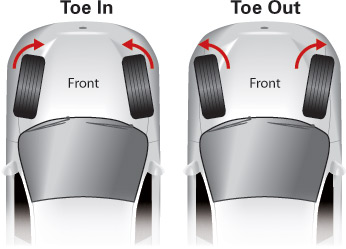 The use of the terms "toe in and toe out" describes whether the front edges of the tyres are closer together or further apart than the 'straight-ahead' direction. Or, put simply, imagine you are standing up straight with your feet about 10cm apart. Moving your toes outwards (away from each other) by a couple of cm each is 'toe out'. If you constantly walked along like this you would wear the inside edges of your shoes more than the outsides. Likewise, 'toe-in' will have the opposite effect. Different types of vehicles generally require different "toe" settings depending on the way the wheels either pull towards each other or apart. A small amount of 'toe' is usually desirable for the rear tyres to increase friction and help keep them at the right temperature, especially in cold weather and therefore optimise road-holding.
The use of the terms "toe in and toe out" describes whether the front edges of the tyres are closer together or further apart than the 'straight-ahead' direction. Or, put simply, imagine you are standing up straight with your feet about 10cm apart. Moving your toes outwards (away from each other) by a couple of cm each is 'toe out'. If you constantly walked along like this you would wear the inside edges of your shoes more than the outsides. Likewise, 'toe-in' will have the opposite effect. Different types of vehicles generally require different "toe" settings depending on the way the wheels either pull towards each other or apart. A small amount of 'toe' is usually desirable for the rear tyres to increase friction and help keep them at the right temperature, especially in cold weather and therefore optimise road-holding.
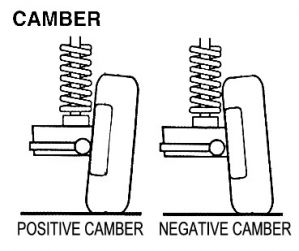 The term "camber" is used to describe the outward or inward tilt of the tyre compared to the vertical. The camber will also be set by the vehicle manufacturer though it may need to be adjusted periodically due to potholes in the road. As with toe, a certain amount of camber is often desirable to achieve the best performance (grip to the road surface) from tyres, especially when cornering.
The term "camber" is used to describe the outward or inward tilt of the tyre compared to the vertical. The camber will also be set by the vehicle manufacturer though it may need to be adjusted periodically due to potholes in the road. As with toe, a certain amount of camber is often desirable to achieve the best performance (grip to the road surface) from tyres, especially when cornering.
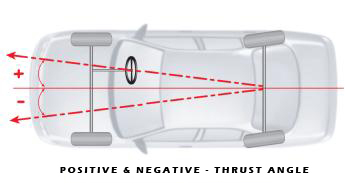 Another term often used by wheel alignment professionals is "thrust angle". This describes the angle of the rear axle (usually an imaginary rear axle these days) to the centre line of the vehicle. Imagine driving a fork lift truck where the steering is at the rear. A very slight movement of the rear wheels will send the truck off in a very different direction to the centre line. In other words road vehicles are very sensitive to thrust angle and it's more important than many people realise! '4-wheel' or '3-D' alignment systems measure the vehicle's thrust angle and on some cars it's now possible to adjust it to bring it to zero. If it's not possible to adjust this, then the software in the alignment computer will take account of it and advise the correct adjustments in the front wheels to compensate.
Another term often used by wheel alignment professionals is "thrust angle". This describes the angle of the rear axle (usually an imaginary rear axle these days) to the centre line of the vehicle. Imagine driving a fork lift truck where the steering is at the rear. A very slight movement of the rear wheels will send the truck off in a very different direction to the centre line. In other words road vehicles are very sensitive to thrust angle and it's more important than many people realise! '4-wheel' or '3-D' alignment systems measure the vehicle's thrust angle and on some cars it's now possible to adjust it to bring it to zero. If it's not possible to adjust this, then the software in the alignment computer will take account of it and advise the correct adjustments in the front wheels to compensate.
Drivers should monitor unusual wear on their tyres such as increased wear on the inside or outside shoulder of the tyre, this is a clear sign of misaligned wheels through any of toe-in, toe-out, camber or thrust angle.

